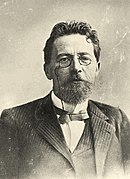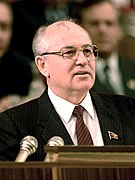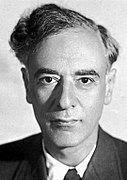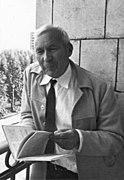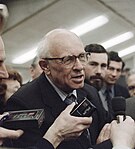You can help expand this article with text translated from the corresponding article in Russian. (June 2024) Click for important translation instructions.
|
| Московский государственный университет имени М. В. Ломоносова | |
 Moscow State University Main Building Moscow State University Main Building | |
| Motto | Наука есть ясное познание истины, просвещение разума |
|---|---|
| Motto in English | Science is clear knowledge of the truth, enlightenment of the mind Scientia est clara cognitio veritatis, illustratio mentis (Latin) |
| Type | Public research university |
| Established | 23 January 1755; 269 years ago (1755-01-23) |
| Rector | Viktor Sadovnichiy |
| Academic staff | 5,000 |
| Students | 39282 |
| Location | Moscow, Russia 55°42′14″N 37°31′43″E / 55.7039°N 37.5286°E / 55.7039; 37.5286 |
| Campus | Urban |
| Language | Russian |
| Colors | |
| Affiliations | Association of Professional Schools of International Affairs (cancelled in 2022) Institutional Network of the Universities from the Capitals of Europe (suspended in 2022) International Forum of Public Universities |
| Website | msu |
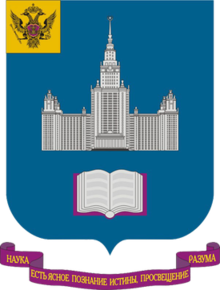 | |
| Building details | |
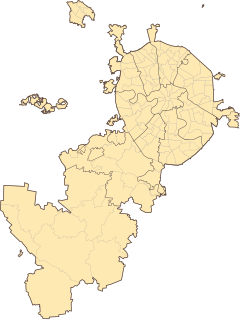 | |
| General information | |
| Completed | 1953 |
| Height | |
| Architectural | 240 m (787 ft) |
| Top floor | 214 m (702 ft) |
| Technical details | |
| Floor count | 42 |
| Floor area | 1,000,000 m (10,763,910.417 sq ft) |
Moscow State University (MSU), officially M. V. Lomonosov Moscow State University, is a public research university in Moscow, Russia. The university includes 15 research institutes, 43 faculties, more than 300 departments, and six branches. Alumni of the university include past leaders of the Soviet Union and other governments. As of 2019, 13 Nobel laureates, six Fields Medal winners, and one Turing Award winner were affiliated with the university.
History

Imperial Moscow University
Main article: Imperial Moscow University
Ivan Shuvalov and Mikhail Lomonosov promoted the idea of a university in Moscow, and Russian Empress Elizabeth decreed its establishment on 23 January [O.S. 12 January] 1755.
The first lectures were given on 7 May [O.S. 26 April]. Saint Petersburg State University and MSU each claim to be Russia's oldest university. Though Moscow State University was founded in 1755, St. Petersburg which has had a continuous existence as a "university" since 1819 sees itself as the successor of an academy established on in 1724, by a decree of Peter the Great.
MSU originally occupied the Principal Medicine Store on Red Square from 1755 to 1787. Catherine the Great transferred the university to a building on the other side of Mokhovaya Street, constructed between 1782 and 1793, to a design by Matvei Kazakov, and rebuilt by Domenico Giliardi after fire consumed much of Moscow in 1812.

In the 18th century, the university had three departments: philosophy, medicine, and law. A preparatory college was affiliated with the university until its abolition in 1812. In 1779, Mikhail Kheraskov founded a boarding school for noblemen (Благородный пансион) which in 1830 became a gymnasium for Russian nobility. The university press, run by Nikolay Novikov in the 1780s, published the newspaper in Imperial Russia: Moskovskie Vedomosti.
In 1804, medical education split into clinical (therapy), surgical, and obstetrics faculties. Between 1884 and 1897, the Department of Medicine built a medical campus in Devichye Pole, between the Garden Ring and Novodevichy Convent; designed by Konstantin Bykovsky, with university doctors like Nikolay Sklifosovskiy and Fyodor Erismann acting as consultants. The campus, and medical education in general, were separated from Moscow University in 1930. Devichye Pole was operated by the independent I.M. Sechenov First Moscow State Medical University and by various other state and private institutions.
The roots of student unrest in the university reach deep into the nineteenth century. In 1905, a social-democratic organization emerged at the university and called for the overthrow of the Czarist government and the establishment of a republic in Russia. The imperial government repeatedly threatened to close the university. In 1911, in a protest over the introduction of troops onto the campus and mistreatment of certain professors, 130 scientists and professors resigned en masse, including Nikolay Dimitrievich Zelinskiy, Pyotr Nikolaevich Lebedev, and Sergei Alekseevich Chaplygin; thousands of students were expelled.
Moscow State University
1917–49
After the October Revolution of 1917, the institution began to admit children of the proletariat and peasantry. In 1919, the university abolished tuition fees, and established a preparatory facility to help working-class children prepare for entrance examinations. During the implementation of Joseph Stalin's first five-year plan (1928–32), prisoners from the Gulag were forced to construct parts of the newly expanded university.
1950–99

In 1970, the university imposed a 2% quota on Jewish students. A 2014 article entitled "Math as a tool of anti-semitism" in The Mathematics Enthusiast discussed antisemitism in the Moscow State University's Department of Mathematics during the 1970s and 1980s.
In the mid-1980s, the Dean of MSU's law faculty was dismissed for taking bribes. After 1991, nine new faculties were established. The following year, the university gained a unique status: it is funded directly from the state budget (bypassing the Ministry of Education).
On 6 September 1997, French electronic musician Jean Michel Jarre used the front of the university as the backdrop for a concert. The concert attracted a paying crowd of half a million people.
2000–2020

In 2007, MSU Rector Viktor Sadovnichy said that corruption in Russia's education system was a "systemic illness," and that he had seen an ad guaranteeing a perfect score on entrance exams to MSU, for a significant fee.
On 19 March 2008, Russia's most powerful supercomputer to date, the SKIF MSU (Russian: СКИФ МГУ; skif means 'Scythian' in Russian) was launched at the university. Its peak performance of 60 TFLOPS (LINPACK – 47.170 TFLOPS) made it the fastest supercomputer in the Commonwealth of Independent States.
In November 2012, Mikhail Basharatyan, Deputy Dean of the MSU World Economy Department, was fired for taking a bribe from a pupil. In February 2013, Andrei Andriyanov resigned as head of the Kolmogorov Special Educational and Scientific Center of the university, after an investigation concluded that he had included fake references in his doctoral thesis.
2020–present
In March 2022, Victor Sadovnichy, rector of Moscow State University and president of the Russian Union of Rectors, was the lead signature in a public statement endorsing the 2022 Russian invasion of Ukraine. In reaction, Academia Europaea, a pan-European academy, suspended the membership of Sadovnichy. In response to the Russian invasion, that same month Yale University, the Hamburg University of Applied Sciences, University of Potsdam, and HKU Business School suspended their longstanding relationships with the university, and the University of St Andrews suspended a joint master's degree programme with the university. Intel and AMD, the largest chip manufacturers in the world, whose processors are used in the Moscow State University supercomputer, as well as Nvidia, reacted by suspending deliveries of their processors to Russia.
Campus
Main article: Main building of Moscow State University
Since 1953, most of the faculties have been situated on Sparrow Hills, in southwest Moscow. In the post-war era, Joseph Stalin ordered seven tiered neoclassic towers to be built around the city. It was built using Gulag labour, as were many of Stalin's Great Construction Projects in Russia. The MSU main building was the tallest building in Europe until 1990. The central tower is 240 m tall, 36 stories high.

Along with the university administration, the Museum of Earth Sciences and faculties of Mechanics and Mathematics, Geology, Geography, and Fine and Performing Arts are in the main building. The building on Mokhovaya Street houses the Faculty of Journalism, the Faculty of Psychology, and Institute of Asian and African Countries. A number of faculty buildings are located near Manege Square in the centre of Moscow and a number of campuses abroad in Ukraine, Kazakhstan, Tajikistan and Uzbekistan. The Ulyanovsk branch of MSU was reorganized into Ulyanovsk State University in 1996.
Faculties


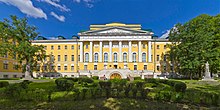
As of 2009, the university had 39 faculties and 15 research centres. A number of small faculties opened, such as Faculty of Physics and Chemistry and Higher School of Television. The full list of faculties is as follows:
- Faculty of Mechanics and Mathematics
- Faculty of Computational Mathematics and Cybernetics
- Faculty of Physics
- Faculty of Chemistry
- Faculty of Materials Science
- Faculty of Biology
- Faculty of Bioengineering and Bioinformatics [ru]
- Faculty of Soil Science [ru]
- Faculty of Geology [ru]
- Faculty of Geography
- Faculty of Fundamental Medicine
- Faculty of Space Research
- Faculty of History
- Faculty of Philology [ru]
- Faculty of Philosophy [ru]
- Faculty of Economics
- Faculty of Law
- Faculty of Journalism
- Faculty of Psychology
- Institute of Asian and African Countries
- Faculty of Sociology [ru]
- Faculty of Foreign Languages and Area Studies [ru]
- Faculty of Public Administration [ru]
- Faculty of World Politics [ru]
- Faculty of Political Science
- Faculty of Fine and Performing Arts
- Faculty of Global Studies
- Faculty of Education
- Graduate School of Business Administration
- Faculty of Physics and Chemistry
- Moscow School of Economics
- Graduate School of Translation and Interpretation
- Graduate School of Public Administration
- Graduate School of Public Audit
- Graduate School of Administration and Innovations
- Graduate School of Innovative Business Administration
- Graduate School of Contemporary Social Sciences
- Graduate School of Television
- Center of Military Training
Institutions and research centers
- Skobeltsyn Institute of Nuclear Physics
- Institute of Mechanics
- Sternberg Astronomical Institute
- A.N. Belozersky Institute of Physico-Chemical Biology
- Research Computing Center
- N.N. Bogolyubov Institute for Theoretical Problems of Microphysics
- White Sea Biological Station
- Moscow University Herbarium
Academic reputation
| University rankings | |
|---|---|
| Global – Overall | |
| ARWU World | 101–150 (2024) |
| QS World | 87 (2024) |
| THE World | 107 (2022) |

In world rankings, MSU was ranked 101st–150th by the Academic Ranking of World Universities 2024, #87 by QS World University Rankings 2024.
According to the major global university rankings, MSU is by far the highest-ranked, and most selective Russian university, and the highest ranking university in Eastern Europe.
The university has contacts with universities throughout the world, exchanging students and lecturers. It houses the UNESCO International Demography Courses and Hydrology Courses. In 1991 the French University College, the Russian-American University, and the Institute of German Science and Culture were opened.
The institution's academic reputation was severely undermined because of its support for the 2022 Russian invasion of Ukraine. (See: sanctions).
Staff and students
The university employs more than 4,000 academics and 15,000 support staff. Approximately 5,000 researchers work at the university's research institutes and facilities. More than 40,000 undergraduates and 7,000 advanced degree candidates are enrolled. Annually, the university hosts approximately 2,000 students, graduate students, and researchers from around the world.
Notable people
Main article: List of Moscow State University people| Notable alumni of Moscow State University |
|---|
As of 2017, 13 Nobel laureates, 6 Fields Medal winners and one Turing Award winner had been affiliated with the university. It is the alma mater of writers Anton Chekhov, Boris Pasternak, and Ivan Turgenev; politicians Mikhail Gorbachev, Mikhail Suslov, and Ruslan Khasbulatov; and mathematicians and physicists Vladimir Arnold, Boris Demidovich, Vladimir Drinfeld, Vitaly Ginzburg, Andrey Kolmogorov, Grigory Margulis, Andrei Sakharov, and Yakov Sinai.
Moscow State University in philately
Main article: ru:Московский государственный университет § МГУ в филателии- Russian and Soviet stamps
-
 1950 postage stamp:
1950 postage stamp:
the project of the 26-storey building of Moscow State University -
 1955 postage stamp:
1955 postage stamp:
the old university building -
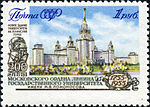 1955 postage stamp:
1955 postage stamp:
the new university building -
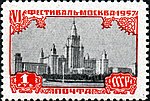 1957 postage stamp:
1957 postage stamp:
Moscow Festival of Youth and Students -
 1958 postage stamp:
1958 postage stamp:
V Congress of the International Union of Architects -
 1958 postage stamp:
1958 postage stamp:
X Congress of the International Astronomical Union in the new university building -
 2002 postage stamp:
2002 postage stamp:
200th anniversary of the Ministry of Education of the Russian Federation -
 2005 postage stamp:
2005 postage stamp:
250th anniversary of Moscow State University
See also
- Education in Russia
- List of early modern universities in Europe
- List of universities in Russia
- List of rectors of Moscow State University
- List of honorary professors of the Moscow State University
Notes
- Russian: Московский государственный университет имени М. В. Ломоносова, romanized: Moskovskij gosudarstvennyj universitet imeni M. V. Lomonosova, IPA: [mɐˈskofskʲɪj ɡəsʊˈdarstvʲɪn(ː)ɨj ʊnʲɪvʲɪrsʲɪˈtʲet ˈimʲɪnʲɪ ɛmˈvɛ ləmɐˈnosəvə].
References
- "Крупнейшие вузы России: анализируем востребованность российских университетов" (in Russian). ng.ru. Retrieved 2024-04-18.
- "Where is Lomonosov Moscow State University, Moscow, Russia on Map Lat Long Coordinates". Latlong.net.
- "Faculty of Physics". M. V. Lomonosov Moscow State University Faculty of Physics. Archived from the original on 2022-11-04. Retrieved 2022-11-04.
- Barry A. Kosmin. "Resentment, Anxiety and Careerism: Accounting for Antisemitism in the Academy and Among the Intelligentsia" (PDF). Isgap.org. Retrieved 2022-07-25.
- Jay Egenhoff (2014). "Math as a tool of anti-semitism". The Mathematics Enthusiast. 11 (3). Retrieved 2022-07-25.
- Malseed, Mark (May 6, 2013). "The Story of Sergey Brin". Momentmag.com.
- Googled: The End of the World as We Know It. Penguin. 2009. ISBN 9781101151402.
- The Emancipation of Soviet Law. Martinus Nijhoff Publishers. 1992. ISBN 9780792314363.
- "Mad Max Fury Road: Ten Road Warrior themed world records". Guinness World Records. May 15, 2015.
- Opening the Red Door: The Inside Story of Russia's First Christian Liberal Arts University. InterVarsity Press. 2019. ISBN 9780830865178.
- "8th edition of the Top 50 list of the most powerful computers in Russia released". Top500.org. TOP500 Supercomputing Sites. 2008-04-16. Archived from the original on 2011-09-27. Retrieved 2011-10-29.
- "ru:В МГУ запустили мощнейший в СНГ компьютер". Km.ru. 2008-03-20. Retrieved 2016-07-14.
- "Basharatyan fired from MSU for receiving bribe". en.vestikavkaza.ru. 2 November 2012.
- Times, The Moscow (October 30, 2012). "Professors Caught Taking Hefty Bribe". The Moscow Times.
- "Scandals Envelop Two Russian Science Officials; Allegations of a falsified dissertation lead to departure of head of special science high school". science.org.
- ^ "MILTA: Russian Colleges are calling for war. Will Yale react?". Yale Daily News. March 15, 2022.
- ^ "Обращение Российского Союза ректоров 04.03.2022". Российский Союз Ректоров. March 4, 2022. Archived from the original on 2022-03-07.
- "European infrastructures advised to block Russian access". Researchprofessionalnews.com. March 17, 2022.
- "Yale Daily News: What Does the Future Hold for Russian Studies at Yale? | Russian, East European, & Eurasian Studies at Yale". Reees.macmillan.yale.edu.
- "Exchange Partners | Undergraduate – FBE – HKU". ug.hkubs.hku.hk.
- Kampfner, Constance. "Scottish universities' Russian links come under urgent review". Thetimes.co.uk.
- "Solidarity with Ukraine / Tolerance on our international campus" (PDF). Hasw-hamburg.de. Retrieved 2022-07-25.
- Brodersen, Dr Phil Silke. "University Partnerships". Uni-potsdam.de.
- "AMD and Intel have suspended deliveries of their products to Russia – RBC". Time.news. February 26, 2022.
- "What are the supercomputers of Sberbank, Yandex and MTS, the operation of which will be affected by the ban on NVIDIA software". Gadgetonus.com. July 2022.
- Figes, O. (2013) 'Just Send Me Word – A True Story of Love and Survival in the Gulag' p. 192, Penguin Books: London.
- Stalinist Reconstruction and the Confirmation of a New Elite, 1945–1953. Springer. 2001. ISBN 9781403919458.
- Stalinism: Russian and Western Views at the Turn of the Millennium. Psychology Press. 2005. ISBN 9780415351089.
- "Как строились сталинские высотки". РБК (in Russian). 2017-09-07. Retrieved 2024-07-22.
- "Ulyanovsk state university, Fee structure 2022 Ulyanovsk State Medical University Admission". December 1, 2021.
- "Подразделения МГУ". Msu.ru.
- "Moscow State University – Shanghai Ranking". Shanghai Ranking.
- "Top Universities". Top Universities.
- "M. V. Lomonosov Moscow State University". Usnews.com. Retrieved 2022-07-25.
- "World University Rankings". insidehighered.com. 2019.
- "Moscow State University – Shanghai Ranking". www.shanghairanking.com. Retrieved 2022-12-03.
- "Lomonosov Moscow State University". Top Universities. Retrieved 2025-01-20.
- ^ "About MSU". www.journ.msu.ru.
External links
| International Forum of Public Universities | |
|---|---|
| Europe | |
| Americas | |
| Asia | |
| Africa | |
| BRICS Universities League | |
|---|---|
| Brazil | |
| Russia | |
| India | |
| China | |
| South Africa | |
- Moscow State University
- Buildings and structures built in the Soviet Union
- Stalinist architecture
- Tourist attractions in Moscow
- Public universities and colleges in Russia
- 1755 establishments in the Russian Empire
- Educational institutions established in 1755
- Universities and colleges established in the 18th century

